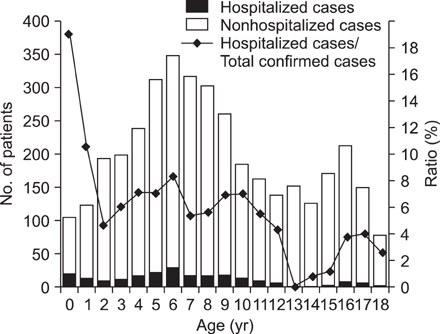Tuberc Respir Dis.
2012 Jun;72(6):493-500.
Clinical Characteristics of Pandemic Influenza A (H1N1) 2009 Pediatric Infection in Busan and Gyeongsangnam-do: One Institution
- Affiliations
-
- 1Department of Pediatrics, Seoul National University College of Medicine, Seoul, Korea.
- 2Department of Pediatrics, Pusan National University College of Medicine, Busan, Korea. limyt@pusan.ac.kr
Abstract
- BACKGROUND
This study investigated the clinical characteristics and risk factors of the severity of pandemic influenza A (H1N1) 2009 infection in pediatric patients in Busan and Gyeongsangnam-do.
METHODS
Cases of influenza A (H1N1) 2009 in patients under the age of 18 years, confirmed by reverse transcription polymerase chain reaction, at Pusan National University Hospital and Pusan National University Yangsan Hospital from the last week of August 2009 through the last week of February 2010 were retrospectively analyzed.
RESULTS
Of the 3,777 confirmed cases of influenza A (H1N1) 2009, 2,200 (58.2%) were male and 1,577 (41.8%) were female. The average age of the patients was 8.4+/-4.8 years. The total cases peaked during 44th to 46th week. Most of the patients were in the 5- to 9-year-old age group. Oseltamivir was administered to 2,959 (78.3%) of the patients. 221 patients (5.9%) were hospitalized, age an average of 6.7+/-4.5 years. The average duration of hospitalization was 7.4+/-5.6 days. One hundred cases (45.2%) had pneumonia. Risk factors for hospitalization included male gender, <2 years of age, and underlying disease. Children with asthma were at very high risk of hospitalization, over 20 times the non-asthmatic children (odds ratio [OR], 21.684; confidence interval [CI], 13.295~39.791). Likewise the children with neurologic deficits faced a 16 times higher risk (OR, 15.738; CI, 7.961~31.111). Ten of the patients (4.5%) were admitted to the intensive care unit, and eight (3.6%) required mechanical ventilation.
CONCLUSION
Of the pediatric patients with pandemic influenza A (H1N1) 2009, most of the patients were in the 5- to 9-year-old age group. Risk factors for hospitalization included male gender, <2 years of age, and underlying disease. The most common complication was pneumonia. The very high risk of severe morbidity in children with asthma or neurologic disease shows the critical importance of targeted vaccine coverage, special awareness and swift care by both guardians and primary care providers.
MeSH Terms
-
Asthma
Child
Epidemiologic Study Characteristics as Topic
Female
Hospitalization
Humans
Influenza A Virus, H1N1 Subtype
Influenza, Human
Intensive Care Units
Male
Neurologic Manifestations
Oseltamivir
Pandemics
Pediatrics
Pneumonia
Polymerase Chain Reaction
Primary Health Care
Retrospective Studies
Reverse Transcription
Risk Factors
Oseltamivir
Figure
Reference
-
1. World now at the start of 2009 influenza pandemic. World Health Organization. cited 2011 Dec 10. Geneva: World Health Organization;Available from: http://who.int/mediacentre/news/statements/2009/h1n1_pandemic_phase6_20090611/en/index.html.2. Pandemic (H1N1) 2009: update 112. World Health Organization. cited 2009 Dec 10. Geneva: World Health Organization;Available from: http://www.who.int/csr/don/2010_08_06/en/.3. Korea Centers for Disease Control and Prevention. Analysis of reported pandemic influenza (A/H1N1 2009) virus infections in Korea: from April, 2009 through August, 2010. Public Health Wkly Rep. 2010. 38:637–642.4. Kim WJ. Epidemiologic and clinical characteristics of pandemic influenza (1918-2009). Infect Chemother. 2009. 41:Suppl 2. 5.5. O'Riordan S, Barton M, Yau Y, Read SE, Allen U, Tran D. Risk factors and outcomes among children admitted to hospital with pandemic H1N1 influenza. CMAJ. 2010. 182:39–44.6. Libster R, Bugna J, Coviello S, Hijano DR, Dunaiewsky M, Reynoso N, et al. Pediatric hospitalizations associated with 2009 pandemic influenza A (H1N1) in Argentina. N Engl J Med. 2010. 362:45–55.7. Bettinger JA, Sauvé LJ, Scheifele DW, Moore D, Vaudry W, Tran D, et al. Pandemic influenza in Canadian children: a summary of hospitalized pediatric cases. Vaccine. 2010. 28:3180–3184.8. Da Dalt L, Chillemi C, Cavicchiolo ME, Bressan S, Calistri A, Palù G, et al. Pandemic influenza A (H1N1v) infection in pediatric population: a multicenter study in a north-east area of Italy. Ital J Pediatr. 2011. 37:24.9. Carcione D, Giele C, Dowse GK, Mak DB, Goggin L, Kwan K, et al. Comparison of pandemic (H1N1) 2009 and seasonal influenza, Western Australia, 2009. Emerg Infect Dis. 2010. 16:1388–1395.10. Jhung MA, Swerdlow D, Olsen SJ, Jernigan D, Biggerstaff M, Kamimoto L, et al. Epidemiology of 2009 pandemic influenza A (H1N1) in the United States. Clin Infect Dis. 2011. 52:Suppl 1. S13–S26.11. Bandaranayake D, Jacobs M, Baker M, Hunt D, Wood T, Bissielo A, et al. The second wave of 2009 pandemic influenza A(H1N1) in New Zealand, January-October 2010. Euro Surveill. 2011. 16:pii: 19788.12. Jain S, Kamimoto L, Bramley AM, Schmitz AM, Benoit SR, Louie J, et al. Hospitalized patients with 2009 H1N1 influenza in the United States, April-June 2009. N Engl J Med. 2009. 361:1935–1944.13. Bagdure D, Curtis DJ, Dobyns E, Glodé MP, Dominguez SR. Hospitalized children with 2009 pandemic influenza A (H1N1): comparison to seasonal influenza and risk factors for admission to the ICU. PLoS One. 2010. 5:e15173.14. Okada T, Morozumi M, Matsubara K, Komiyama O, Ubukata K, Takahashi T, et al. Characteristic findings of pediatric inpatients with pandemic (H1N1) 2009 virus infection among severe and nonsevere illnesses. J Infect Chemother. 2011. 17:238–245.15. Launay E, Ovetchkine P, Saint-Jean M, Coïc L, Ducruet T, Charest H, et al. Novel influenza A (H1N1): clinical features of pediatric hospitalizations in two successive waves. Int J Infect Dis. 2011. 15:e122–e130.16. Cox CM, Blanton L, Dhara R, Brammer L, Finelli L. 2009 Pandemic influenza A (H1N1) deaths among children: United States, 2009-2010. Clin Infect Dis. 2011. 52:Suppl 1. S69–S74.
- Full Text Links
- Actions
-
Cited
- CITED
-
- Close
- Share
- Similar articles
-
- Influenza Associated Pneumonia
- 2009 Pandemic Influenza A(H1N1) Infections in the Pediatric Cancer Patients and Comparative Analysis with Seasonal Influenza
- The 2009 H1N1 Pandemic Influenza in Korea
- Clinical and Laboratory Characteristics of Pandemic Influenza A/H1N1 2009 Infection among Patients with Malignancy in Korea
- Epidemiology, clinical manifestations, and management of pandemic novel Influenza A (H1N1)




